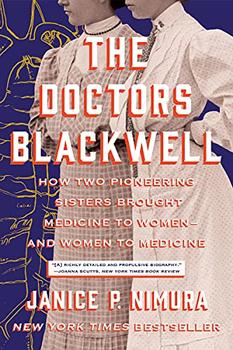Summary | Excerpt | Reading Guide | Reviews | Beyond the Book | Readalikes | Genres & Themes | Author Bio
How Two Pioneering Sisters Brought Medicine to Women and Women to Medicine

Critics' Opinion:
Readers' Opinion:
First Published:
Jan 2021, 336 pages
Paperback:
Jan 2022, 352 pages
 Book Reviewed by:
Book Reviewed by:
Kim Kovacs
Buy This Book
Excerpt
The Doctors Blackwell
The world knows Elizabeth Blackwell as the first woman in America to receive a medical degree, in 1849. Her sister Emily joined her in that distinction in 1854. Their achievements, including the foundation of the first hospital run by and for women, are enshrined in American history.
But in 1845, before Elizabeth became an icon, she was a bored and frustrated 24-year-old, teaching to help support her mother and eight siblings in Cincinnati. It was at this stalled moment that a terminally ill friend planted the seed of an idea. "If I could have been treated by a lady doctor," the woman confided, "my worst sufferings would have been spared me."
Elizabeth scoffed. Why would a young woman enthralled by literature and philosophy suddenly apply her considerable ambition to what was, essentially, still a trade—and not even a lucrative one? Not to mention there was no such thing as a female physician, at least in any honorable sense. Women who claimed that title were peddlers of patent elixirs—or worse, of abortion. Even respectable male doctors, armed with little more than purgatives, laudanum, and lancets, often did more harm than good—she had seen this at her own father's deathbed. On top of this, with the explosion of industrial cities and the epidemics that accompany overcrowding, the general state of human health had rarely been worse. Confidence in the ability of doctors to preserve life had never been lower.
Since childhood, Elizabeth had always hidden signs of illness from her family: Sickness was for the weak. "My favourite studies were history and metaphysics," she wrote, "and the very thought of dwelling on the physical structure of the body and its various ailments filled me with disgust." But her metaphysical orientation eventually directed her toward the science of the body. That winter, Margaret Fuller—editor of the Transcendentalist magazine The Dial—published Woman in the Nineteenth Century, a bestseller that spoke directly to Elizabeth's unsatisfied mind. Humanity would achieve a moral awakening, Fuller insisted, only when women enjoyed the same independence as men—a step that women must claim for themselves. "If you ask me what offices they may fill; I reply—any," wrote Fuller. "I do not care what case you put; let them be sea-captains, if you will." Could it be that "doctor" was the office Elizabeth was meant to fill?
She was not drawn to the daily work of doctoring—that would involve uncomfortably intimate contact with individual sufferers—but becoming a doctor as qualified as any man was a noble ideological quest. Elizabeth's attraction to this challenge wrestled with her distaste for human biology and won. There was, moreover, the added incentive of the recognition that such an extraordinary accomplishment might bring. She had no use for most social interaction, but she had no objection to fame.
Elizabeth visited doctors in Cincinnati and wrote to others in New York, receiving everywhere the same reaction: a female medical student was an interesting idea, but what self-respecting woman would expose herself to the naked realities of the body in the company of men? And then there was the unmentionable question of such a woman's own body, incapacitated monthly. Bedrest was a common prescription for menstrual complaints, and what would a lady doctor's patients do then? Even Elizabeth's friend Harriet Beecher Stowe was dubious. Certainly a woman doctor would be "highly useful," she conceded, but the forces ranged against Elizabeth, which she must "either crush or be crushed by," were formidable.
Of course, women had always served as healers—whether revered as angels at the bedside, or reviled (though still, quietly, consulted) as uncomfortably powerful initiates into the secrets of witchcraft. But as eighteenth-century Enlightenment ideas introduced empirical science and new techniques into the healing arts—like the use of forceps during delivery—female practitioners were replaced by male professionals. As the establishment of medical schools and societies created new frameworks of legitimacy, women were pushed further toward the margins. However: in the last few decades, as medical schools began to proliferate in the United States, it was perhaps easier to argue for a woman's right to be a doctor. If she attended the same lectures and passed the same examinations as a man, who could deny her qualifications?
Excerpted from The Doctors Blackwell by Janice P Nimura . Copyright © 2021 by Janice P Nimura . Excerpted by permission of W.W. Norton & Company. All rights reserved. No part of this excerpt may be reproduced or reprinted without permission in writing from the publisher.





The House on Biscayne Bay
by Chanel Cleeton
As death stalks a gothic mansion in Miami, the lives of two women intertwine as the past and present collide.

The Flower Sisters
by Michelle Collins Anderson
From the new Fannie Flagg of the Ozarks, a richly-woven story of family, forgiveness, and reinvention.

The Funeral Cryer by Wenyan Lu
Debut novelist Wenyan Lu brings us this witty yet profound story about one woman's midlife reawakening in contemporary rural China.
Your guide toexceptional books
BookBrowse seeks out and recommends the best in contemporary fiction and nonfiction—books that not only engage and entertain but also deepen our understanding of ourselves and the world around us.